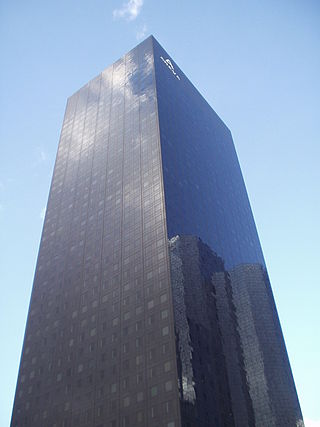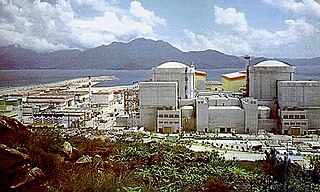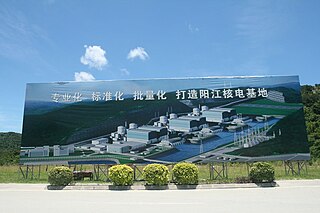The CPR-1000, or CPR1000 (Chinese PWR) is a Generation II+ pressurized water reactor, based on the French 900 MWe three cooling loop design (M310) imported in the 1980s, improved to have a slightly increased net power output of 1,000 MWe (1080 MWe gross) and a 60-year design life.
The CPR-1000 is built and operated by the China General Nuclear Power Group (CGNPG), formerly known as China Guangdong Nuclear Power. Progressively more Chinese manufactured components were used in the units; the second unit built had 70% of its equipment manufactured in China, with a 90% Chinese content target for later builds. [1]
On 15 July 2010, China's first CPR-1000 nuclear power plant, Ling Ao-3, was connected to the grid, [2] having started criticality testing on 11 June 2010. [3] It started commercial operations on 27 September 2010, [4] with Ling Ao-4 starting commercial operation on 7 August 2011. [5]
18 CPR-1000 reactors have been built as of December 2019. [6] Besides Ling Ao unit 3 & 4, the CPR-1000 reactor has been realised in Fangchenggang (unit 1 & 2), Fangjiashan (unit 1 & 2), Hongyanhe (unit 1–4), Ningde (unit 1–4), Yangjiang (unit 1–4). [7]
On the basis of the M310, CGN developed an improved Generation II pressurized water reactor called CPR-1000. [8] CPR-1000 takes a large proportion in all the reactors being built in China. The M310 uses as its base design units 5 & 6 of the Gravelines Nuclear Power Station in France. [1]
The CPR-1000 has a 1086 MWe capacity, a three-loop design and 157 fuel assemblies (active length 12 ft), enriched to 4.5% U-235. The fuel assembly design is AREVA's 17x17 AFA 3G M5, which can be fabricated in China. Other features include has a design life that could extend beyond 40 years and an 18-month fuel cycle. It has a digital instrumentation and control system, and is equipped with hydrogen recombiners and containment spray pumps. [9]
The original M310 reactors at Daya Bay and Ling Ao Phase 1 are sometimes also called CPR-1000s, but these are closely based on the French 900 MWe design (M310), with net power output below 1,000 MWe, and using mostly imported components. [10]
Some CPR-1000 intellectual property rights are retained by Areva, which limits overseas sales potential. [6] However the Financial Times reported in 2010 that Areva was considering marketing the CPR-1000 as a smaller and simpler second-generation reactor design alongside its larger EPR, for countries that are new to nuclear power. [11] [12] In January 2012, CGNPG agreed a partnership with Areva and EDF to develop a reactor based on the CPR-1000, [13] which may create a design converged with Mitsubishi and Areva's 1000 MWe Atmea reactor. [14]
CNP-1000 is a similar 3-loop-design by CNNC, but with a different reactor core.
In 2010, CGNPG announced a further design evolution to a Generation III level, the ACPR-1000, which would also replace intellectual property right-limited components from the CPR-1000. CGNPG aimed to be able to independently market the ACPR-1000 for export by 2013. [15] CGNPG has been conducting the development work in cooperation with Dongfang Electric, Shanghai Electric, Harbin Electric, China First Heavy Industries and China Erzhong. [16]
The core of the ACPR1000 comprises 157 fuel assemblies (active length 14 ft) and has a design life of 60 years. [9] Other features include a core catcher and double containment as additional safety measures [17] and ten major technical improvements over its predecessor the CPR-1000. It was the first Chinese reactor to have a domestically developed digital control system. [18] Unit 5 and 6 at Tianwan Nuclear Power Plant are similarly classified as ACPRs.
Yangjiang 5 was the first construction of an ACPR-1000 reactor, starting in late 2013. [19] It began commercial operation in July 2018.
Following the Fukushima nuclear disaster, a revised design called at the time ACPR-1000+ was described. Features include double containment to protect against external explosions and airplanes, improved seismic capability to 0.3 g, increased core thermal margins and improved operation systems. [20] The gross power output has been increased to 1150 MWe. [21] The ACPR-1000+ was envisaged for export from 2014. [13]
Since 2011, CNNC has been progressively merging its ACP-1000 nuclear power station design [22] with the CGN ACPR-1000 design, while allowing some differences, under direction of the Chinese nuclear regulator. Both are three-loop designs originally based on the same French M310 design used in Daya Bay with 157 fuel assemblies, but went through different development processes (CNNC's ACP-1000 has a more domestic design with 177 fuel assemblies while CGN's ACPR-1000 is a closer copy with 157 fuel assemblies). [23] In early 2014, it was announced that the merged design was moving from preliminary design to detailed design. Power output will be 1150 MWe, with a 60-year design life, and would use a combination of passive and active safety systems with a double containment. CNNC's 177 fuel assembly design was retained.
Initially the merged design was to be called the ACC-1000, [24] [25] [26] but ultimately it was named Hualong One. In August 2014 the Chinese nuclear regulator review panel classified the design as a Generation III reactor design, with independently owned intellectual property rights. [27] [28] As a result of the success of the merger, ACP-1000 and ACPR-1000 designs are no longer being offered.

The EPR is a third generation pressurised water reactor design. It has been designed and developed mainly by Framatome and Électricité de France (EDF) in France, and by Siemens in Germany. In Europe this reactor design was called European Pressurised Reactor, and the internationalised name was Evolutionary Power Reactor, but is now simply named EPR.
The Advanced CANDU reactor (ACR), or ACR-1000, was a proposed Generation III+ nuclear reactor design, developed by Atomic Energy of Canada Limited (AECL). It combined features of the existing CANDU pressurised heavy water reactors (PHWR) with features of light-water cooled pressurized water reactors (PWR). From CANDU, it took the heavy water moderator, which gave the design an improved neutron economy that allowed it to burn a variety of fuels. It replaced the heavy water cooling loop with one containing conventional light water, reducing costs. The name refers to its design power in the 1,000 MWe class, with the baseline around 1,200 MWe.

Framatome is a French nuclear reactor business. It is owned by Électricité de France (EDF) (75.5%), Mitsubishi Heavy Industries (19.5%), and Assystem (5%).

Daya Nuclear Power Plant is a nuclear power plant located in Daya Bay in Longgang District, along the eastern extremity of Shenzhen, Guangdong, China; and to the north east of Hong Kong. Daya Bay has two 944 MWe PWR nuclear reactors based on the Framatome ANP French 900 MWe three cooling loop design (M310), were both commissioned in 1993 and started commercial operation in 1993 and 1994 respectively.

The China National Nuclear Corporation is a state-owned enterprise founded in 1955 in Beijing. CNNC's president and vice-president are appointed by the Premier of the People's Republic of China. CNNC oversees all aspects of China's civilian and military nuclear programs. According to its own mission statement, it "is a main part of the national nuclear technology industry and a leading element of national strategic nuclear forces and nuclear energy development." CNNC is a nationwide industrial conglomerate integrating science, technology, industry, and international trade.
As of 2022, nuclear power is provided by six commercial nuclear power plants in Pakistan. Pakistan is the first Muslim majority country in the world to construct and operate civil nuclear power plants. The Pakistan Atomic Energy Commission (PAEC), the scientific and nuclear governmental agency, is solely responsible for operating these power plants. As of 2018, the electricity generated by commercial nuclear power plants constitutes roughly 7.5% of electricity generated in Pakistan, Pakistan is not a party to the Nuclear Non-Proliferation Treaty but is a member of the International Atomic Energy Agency. Pakistan plans on constructing 32 nuclear power plants by 2050 and envisions 40,000 MW of nuclear power generation.
Ling Ao Nuclear Power Plant (岭澳核电站) is located on the Dapeng Peninsula in Longgang District, Shenzhen, Guangdong, China, about 60 km north of Hong Kong, 1 km north of Daya Bay Nuclear Power Plant. It is operated by China General Nuclear Power Group. The units on site are separated between phase I and phase II.

China is one of the world's largest producers of nuclear power. The country ranks third in the world both in total nuclear power capacity installed and electricity generated, accounting for around one tenth of global nuclear power generated. As of February 2023, China has 55 plants with 57GW in operation, 22 under construction with 24 GW and more than 70 planned with 88GW. About 5% of electricity in the country is due to nuclear energy. These plants generated 417 TWh of electricity in 2022 This is versus the September 2022 numbers of 53 nuclear reactors, with a total capacity of 55.6 gigawatt (GW). In 2019, nuclear power had contributed 4.9% of the total Chinese electricity production, with 348.1 TWh.

Tianwan Nuclear Power Plant is a nuclear power plant (NPP) in the city of Lianyungang in Jiangsu Province, China. It is located on the coast of the Yellow Sea approximately 30 kilometers east of downtown Lianyungang. It is owned by Jiangsu Nuclear Power Corporation, a joint venture mainly owned by the China National Nuclear Power Co., Ltd (CNNP),subsidiary of China National Nuclear Corporation (CNNC).
The Hongyanhe Nuclear Power Plant (红沿河核电站) is located in Donggang Town, Wafangdian in Liaoning Province of China. The site is within the Prefecture-level city of Dalian, 104 kilometres (65 mi) north of Dalian City proper. The first unit started commercial operations in June 2013.
Fangjiashan Nuclear Power Plant (方家山核电站) is a nuclear power plant in the Zhejiang province, China, bordering the Shanghai municipality. The plant consists of two 1,080 MW CPR-1000 pressurized water reactors (PWR) at a total cost of estimated 26 billion yuan.
Ningde Nuclear Power Plant is a nuclear power plant in Fujian province, China. The site is located in Beiwan village in the town of Qinyu, Fuding, Ningde, Fujian. The plant will ultimately have six 1,080 megawatt (MWe) CPR-1000 pressurized water reactors (PWRs). The first reactor began operation on 18 April 2013.The Ningde Nuclear Power project was approved by the National Development and Reform Commission (NDRC) in 2007. The project is 51% funded by the Guangdong Nuclear Investment Company Ltd, with Datang International Power Generation Co and the Fujian Coal Group completing the shareholding. A total investment of 52 billion yuan (US$7.6 billion) should result in the completion of Ningde Phase I. Including the final two units of Phase II, the total cost will exceed 70 billion yuan. The four units of Phase I will generate about 30 billion kilowatt hours per year, for which the plant will charge 0.37 yuan/kW·h.
China General Nuclear Power Group (CGN), formerly China Guangdong Nuclear Power Group (中国广东核电集团), is a Chinese state-owned energy corporation under the SASAC of the State Council.
The Fuqing Nuclear Power Plant is a nuclear power plant in Fuqing, Fujian Province, China. The plant is located on the coast of Xinghua Bay, near Qianxue Village, Sanshan Town. The station has four 1,089 megawatt (MW) CPR-1000 pressurized water reactors (PWRs). The CPR-1000 is an advanced PWR design developed by China from the Areva-designed PWRs at the Daya Bay Nuclear Power Plant. The plant was jointly constructed and is operated by China National Nuclear Corporation (51%), China Huadian Corp. (39%) and the Fujian Investment & Development Co Ltd. (10%).

The Yangjiang Nuclear Power Station is a nuclear power plant in Guangdong province, China. The site is Dongping Town, Yangjiang City in western Guangdong Province. The station has six 1,000 megawatt (MW) CPR-1000 pressurized water reactors (PWRs). The plant began commercial operation in March 2014, and as of 2019 is the largest nuclear power station in China.
In Argentina, about 10% of the electricity comes from 3 operational nuclear reactors: Embalse, a CANDU reactor, and Atucha I and II, two PHWR German designs.

The Hualong One is a Chinese Generation III pressurized water nuclear reactor jointly developed by the China General Nuclear Power Group (CGN) and the China National Nuclear Corporation (CNNC). The CGN version, and its derived export version, is called HPR1000. It is commonly mistakenly referred to in media as the "ACPR1000" and "ACP1000", which are in fact earlier reactors design programs by CGN and CNNC.
The CNP-600 is a pressurized water nuclear reactor developed by the China National Nuclear Corporation (CNNC).
Bradwell B is a proposed nuclear power station at Bradwell-on-Sea in Essex, put forward by China General Nuclear Power Group (CGN). If constructed, the site will provide 2,200 MWe of nuclear power from two UK HPR1000 reactors developed by CGN and the China National Nuclear Corporation (CNNC). It will be located close to the decommissioned Bradwell nuclear power station.
The CNP Generation II nuclear reactors were a series of nuclear reactors developed by China National Nuclear Corporation (CNNC), and are predecessors of the more current Hualong One design.